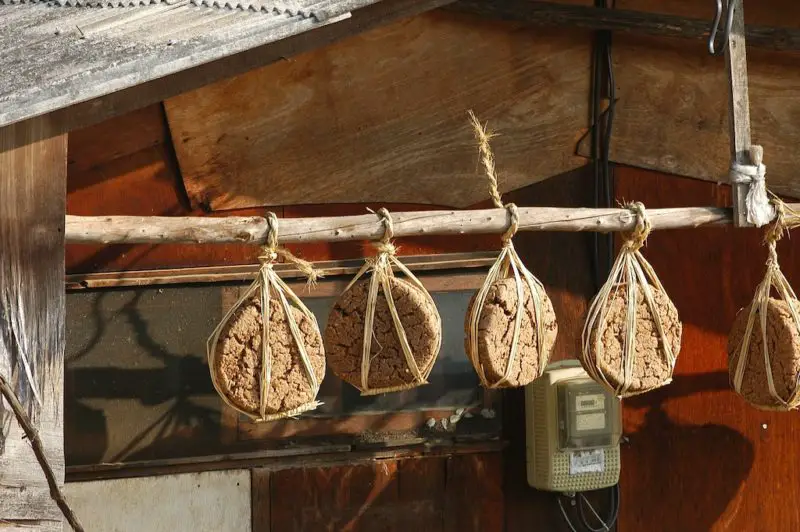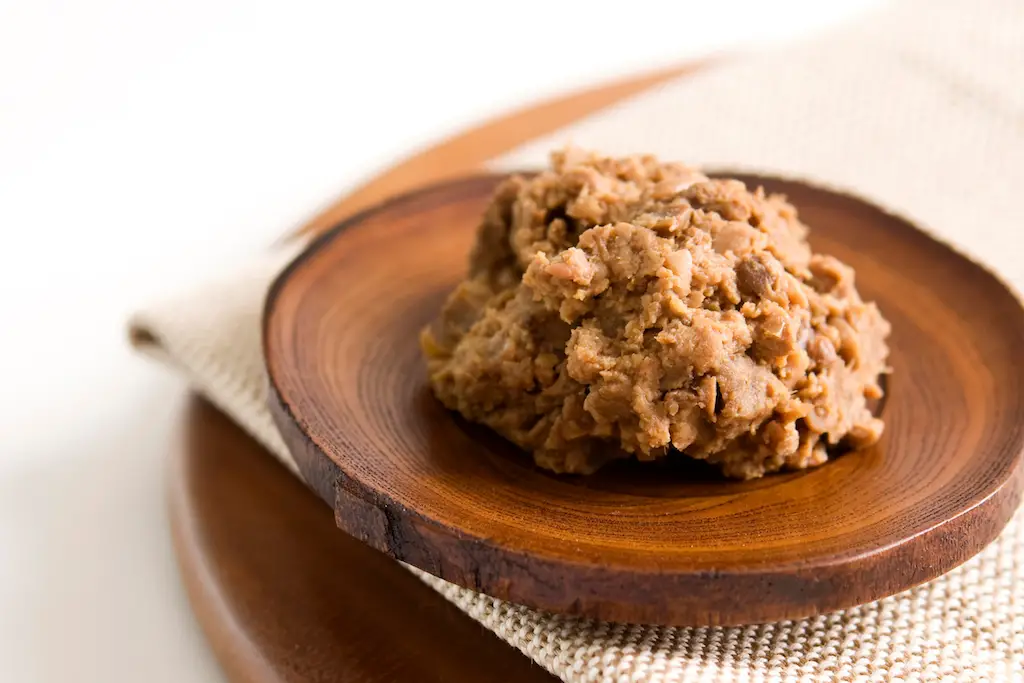This post may contain affiliate links. Please read my disclosure for details at the bottom of this page. As an Amazon Associate, I earn from qualifying purchases on this post about doenjang, otherwise known as Korean soybean paste. We hope you enjoy this article answering the question ‘What Is Doenjang?’
Doenjang, otherwise known as soybean paste, is a Korean fermented ingredient used in much of the cultural cuisine. The word ‘doenjang’ (된장) derives from ‘doen’ (된) meaning ‘thick or hard’ and ‘jang’ (장) meaning ‘paste.’ This Korean ingredient has a complexly earthy and salty flavor with a rich umami profile unique to Korean cooking.
Here, we will discuss the importance of this ingredient to Korean food culture. First, we will talk about the history of doenjang and how it is made. Then, we will delve into the flavor profile and its uses as well as answer some questions you may have about this ingredient!
For further information about Doenjang, I wrote about and published a few articles about the ingredient such as ‘Gluten-Free Doenjang Brands’ and ‘Doenjang vs. Miso: What Is the Difference?’
Doenjang in Korean Culture:
Unlike gochujang, which isn’t mentioned in Korean texts until 1433, the history of doenjang dates back more than 2000 years to the Three Kingdoms Era of Korea (circa 57 BC to 668 AD).
Below, we list some early mentions of doenjang in textual documents, writings, and the arts. Through the years, doenjang became an integral part of Korean food culture!
Some Historical Records of Doenjang:
- Records of the Three Kingdoms: This Chinese historical text, which was published in the 3rd Century AD, possibly mentions doenjang when it states that ‘Goguryeo people are good at brewing fermented soybeans.’ You can find this quote in the Dongyi (Eastern foreigners) section in the Book of Wei.
- Tomb Mural Paintings: In Korea, you can find paintings of jangdoks, otherwise known as onggi, in the murals of the Anak Tomb No.3 from the 4th century Goguryeo period. These jangdoks are fermenting jars or containers used for several different types of fermented food production, including doenjang!
- Samguk Sagi (삼국사기): This text, known as the History of the Three Kingdoms, is a Korean historical record of the Three Kingdoms era. In this text, they wrote about preparing doenjang and ganjang (Korean soy sauce) for King Sinmun’s wedding in February of 683.
- Goryeosa (고려사): Known as the History of Goryeo, it mentions doenjang and ganjang in the Sikhwaji section of the text. Written nearly a century after the fall of Goryeo, during the reign of King Sejong (1418-1450), it details the history of the kingdom. In the text, doenjang and ganjang are mentioned as relief supplies after an invasion in 1018 and when famine swept the nation in 1052.
- Jeungbo Sallim Gyeongje: This Joseon Dynasty text, known as Revised Farm Management in English, contains detailed explanations of how to brew high-quality doenjang and ganjang.
- Dongui Bogam: In 1613 this book of medicine, known as A Precious Mirror of Eastern Medicine in English, was first published. In this text, they described how to use doenjang medically as well as the fermented paste’s medical properties.
- Gyuhap Chongseo: This Joseon Dynasty Text, roughly translated as Women’s Encyclopedia, is a comprehensive text of advice for women written in 1809. In this text, they advice about how to pick a brewing date and how to preserve doenjang and ganjang.
How Do You Make Doenjang?

Made entirely of soybean and brine, doenjang is a byproduct of making soup soy sauce. To start, people in Korea prepare ‘meju’ (메주), a thick brick made of dried and fermented soybeans, in early to mid-November. To do so, they soak the beans overnight before boiling them in saltwater. Then, they either pound the soybeans with a mortar or grind them in a millstone. Finally, people shape the soybean mash into a cube or thick sphere known as ‘meju’ bricks. Then, they dry these bricks in a cool, dark area for a period until firm.
Then, once hardened, the meju blocks are tied with rice straws to the eaves or beams of the home. Note that different areas of Korea have different traditions of how to hang or dry the meju bricks.
Finally, people place the meju to age in jangdok (also known as onggi) with brine. People often add further ingredients, such as charcoal or chilies, to the onggi for their antibacterial properties. Once fermented, the excess liquid is filtered and boiled to become Korean soy sauce while the aged meju chucks are further mashed down to become doenjang.
Culture Note: Traditionally, people also add charcoal or chilies to the onggi as they believed it helped to drive evil spirits away.
Doenjang in Korean Cooking:
In South Korea, people use doenjang in many recipes. Besides ganjang (Korean soy sauce), sesame oil, and gochujang, it is probably the most used fermented condiment. Below, I list a few examples of Korean dishes that use doenjang:
How to Use Korean Soybean Paste:
- Ssamjang (쌈장): Ssamjang is a thick dipping sauce often served with Korean barbecue. While the ingredients change from recipe to recipe, it always contains doenjang and gochujang.
- Doenjang Jjigae (김치찌개): Doenjang jjigae is a type of Korea stew. You make this dish using Korean soybean paste as the base flavor. It tastes slightly salty and earthy. During the winter, this thick stew is the perfect dish to warm the body.
- Bossam (보쌈): Bossam refers to a Korean pork dish made by boiling pork belly. Often, people add doenjang as a seasoning ingredient as the pork boils.
This is just a short list of doenjang use examples. People in Korea use doenjang in a multitude different soups, marinades, and more.

Korean Soybean Paste Paste Frequently Asked Questions:
Now that we learned about Korean soybean paste, we can answer some questions you may have about this condiment! If we did not answer your question, feel free to leave a comment below or email us at [email protected].
Where Can I Buy Doenjang?
Nowadays, you can typically find doenjang in a well-stocked grocery store. Look for it on the Asian aisle. If your grocery store does not carry doenjang, you can easily find it on Amazon or other online markets.
Or, you can always check if your town has a local Asian market. Often, these small groceries are family-run. Further, many cities have large Asian market chains such as H-Mart.
Is Doenjang Gluten-Free?
Many people ask: ‘Is doenjang gluten-free?’. Unfortunately, most Korean doenjang brands contain gluten as a main ingredient.
That being said, gluten-free doenjang options are starting to appear on the market! As someone with celiac disease, further gluten-free options help me cook food from my husband’s childhood and early adulthood.
On the blog, I have a list of my favorite gluten-free doenjang brands. Check the list out if you are gluten-free like me!
Further, check out our guide for gluten-free gochujang brands if you are interested in cooking with gochujang (Korean soybean paste)
How to Store Korean Soybean Paste?
After buying soybean paste, you can store unopened containers in a cool and dark place, unless it states otherwise. Once opened, always place doenjang in the refrigerator.
How Long Does Soybean Paste Last?
Doenjang stays fresh for a long time. When stored properly, an opened container of your typical commercial brand doenjang can stay good for up to a year.
We Hope You Enjoyed Learning About Doenjang (Korean Soybean Paste)!
In the end, I hope you enjoyed learning about Korean soybean paste. If so, let me know in the comment section below! Further, let me know of recipes you cook at home that use this ingredient!
If you would like to read more about cooking, you can find further recipes on this blog. I listed some of my favorite Carving A Journey recipes below! For reference, many recipes are influenced by my family’s blended Korean and Southern heritage.
Korean Ingredient Articles:
- Mung Bean Sprouts in Korean Cooking
- Green Plums in Korean Cooking (Maesil)
- What are Perilla Leaves (Kkaennip)?
- Dangmyeon (Sweet Potato Glass Noodles)
- Gochugaru (Korean Pepper Powder)
- Korean Soy Sauce: What Should I Buy?
- Gluten-Free Gochujang Brands; And
- Gluten-free Doenjang Brands
If you have any questions or comments, you can also email me at [email protected]. And, finally, I would love to hear from you through our social media as well! You can follow me at @carvingajourney on Instagram, Facebook, and Pinterest. I also started a vlog YouTube channel with my husband! Or, if you would like more articles like these, you can subscribe to the blog by joining the mailing list. I hope you enjoyed learning about the Korean soybean paste! Thank you so much for stopping by!
Carving A Journey is a participant in the Amazon Services LLC Associates Program, an affiliate advertising program designed to provide a means for sites to earn advertising fees by advertising and linking to Amazon.com. Although we may earn commissions for our endorsement, recommendation, testimonial, and/or link to any products or services from this website, these opinions are my own and I fully support these products.

